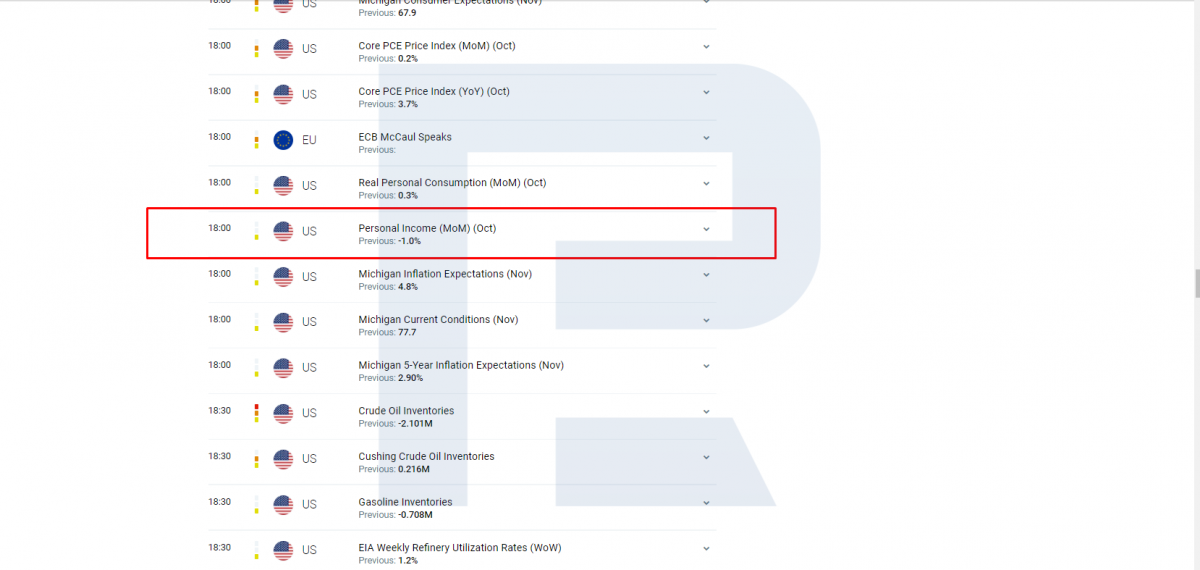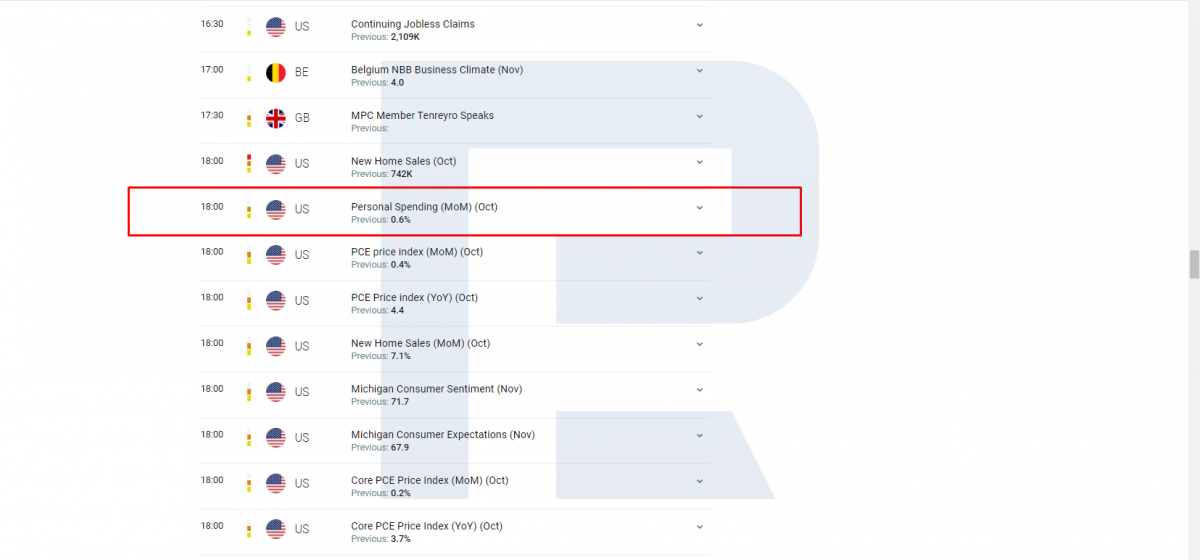This overview focuses on two macroeconomic indicators, Personal Income and Personal Spending, and their impact on the stock market.
What is personal income?
Personal Income is the monthly change in income for physical persons. This indicator measures in percent the change in aggregate income over the reporting month, compared to the previous. Income from multiple sources is used in calculations:
-
Wage/salary
-
Bonuses
-
Real estate ownership can generate income
-
Holding financial assets can generate income
-
Enterprises earn income
-
Subsidies, social payments
-
Insurance, pension, etc.
The Bureau of Economic Analysis (BEA) calculates and publishes Personal Income in the USA.
The BEA uses monthly changes in personal income to assess business activity in the country. The Economic Calendar publishes monthly changes in Personal Income.

Personal Income data on the macroeconomic calendar
What is personal spending?
Personal Spending measures monthly changes in the expenses of individuals. It measures the percentage change in aggregate expenses in the country over the reporting month. This includes all major expenses of the country:
-
Services
-
It is better to spend on durable items than goods
-
Spending money on bank transactions, commissions, etc.
The BEA publishes this indicator monthly, along with Personal Income. PS is used to forecast the GDP's growth. Consumer expenses are part if the GDP. It is also one of the inflation growth indicators. The Economic Calendar publishes the monthly report Changing Personal Spending.

Personal Spending on the Economic Calendar
These indicators have an impact on the currency market.
Personal Income and personal spending are combined to analyze the country's economic impact. Volatility in the currency market may increase if the actual data are significantly different than the forecast.
These indicators typically change by 1-2% on average. The US dollar's rate against other currencies can be affected by unexpected growth or decreases of 3% or more.
These indicators have a modest influence on currency rates. If they both grow or shrink simultaneously, the influence is most obvious.
Market reactions can be unclear if the price dynamics move in opposite directions. For example, one indicator may grow while the other falls. Let's see how the market reacts to simultaneous rises and falls of inductors.
Growth
The USD becomes stronger when there is confidence in the growth of personal income and personal spending. This growth can increase consumer demand, boost GDP growth and accelerate inflation.
The Fed can increase the interest rate to keep the economy from overheating and lower inflation. Investors who purchase the dollar are attracted to the possibility of an increase in the interest rates.
Falling
The USD can also fall against other currencies if both indices are falling rapidly. The decline in personal income and spending is a sign of some unfavorable trends in the economy. This leads to a decrease in GDP and inflation.
The Fed can support the economy with various stimulative measures and a possible decrease in interest rates later on. Investors will sell the dollar based on these expectations.
Trading using the indicators
Forex trading can be done with or without other indicators, such as personal income and personal spending.
Approach to investment
To make long-term currency investments, you need to have substantial capital as well as the ability to analyze the economic dynamics of each country. Fundamental analysis is used to do this: It helps to evaluate changes in Personal Income, Personal Spending, and other data.
Positive dynamics in the indices, which are growth of income and spending, means that the US economy is doing well and the dollar will continue to strengthen. Investors will buy the dollar if other fundamental indices show economic growth. This will cause a long-term uptrend in demand.
A decline in income or spending could lead to negative dynamics in both indices, which might cause a USD downtrend. Investors will sell the dollar in pairs with other currencies if the economic slowdown is confirmed by economic indices. This will allow them to calculate the decline of the USD until it stabilizes and grows again.
Trading for short-term
This is the easiest method to use Personal Income and Personal spending for Forex trading. We can use this opportunity to trade a short-term position if the published data is different from what we forecast. A strong growth in the indices could make the dollar stronger, while a decrease might cause the USD to fall. We try to capture a short-term price momentum that is triggered by data publication.
Tech analysis is useful for short-term trading. We need to determine the market trend and locate support/resistance levels. We can then determine the direction that the quotations will move if there is additional momentum from the published data. Trades with high leverage can result in large profits or losses, so it is important to manage risks.
Learn the fundamental principles of trading news in the article "Trading News - How to Use Strategy and Form A Trading Plan?" ":
Trading the News: Preparing a Trading Plan
Bottom line
The Personal Income and the Personal Spending provide insight into monthly changes in US life. These indices are usually analyzed together with other economic indicators. These indices help to assess market activity and consumer sentiment, draw conclusions about the USD's investment appeal, or highlight the advantages of short-term trading.
--------------------
blog.roboforex.com/blog/2021/11/26/how-to-use-personal-income-and-personal-spending-in-forex/
Did you miss our previous article...
https://11waystomakemoney.com/forex/markets-for-covid19-strain-crashes
 Make Money OnlineForexInvestingBitcoinVideosFinancePrivacy PolicyTerms And Conditions
Make Money OnlineForexInvestingBitcoinVideosFinancePrivacy PolicyTerms And Conditions
